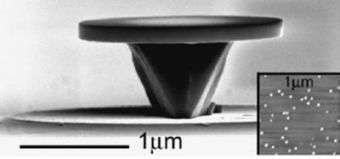Quantum dot lasers -- 1 dot makes all the difference

������Ƶicists at the National Institute of Standards and Technology and Stanford and Northwestern Universities have built micrometer-sized solid-state lasers in which a single quantum dot can play a dominant role in the device’s performance. Correctly tuned, these microlasers switch on at energies in the sub-microwatt range. These highly efficient optical devices could one day produce the ultimate low-power laser for telecommunications, optical computing and optical standards.
How small can a laser get? The typical laser has a vast number of emitters—electronic transitions in an extended crystal, for example—confined within an optical cavity. Light trapped and reflecting back and forth in the cavity triggers the cascade of coherent, laser light. But about a decade ago, researchers made the first quantum dot laser.
Quantum dots are nanoscale regions in a crystal structure that can trap electrons and “holes,” the charge carriers that transport current in a semiconductor. When a trapped electron-hole pair recombines, light of a specific frequency is emitted. Quantum-dot lasers have attracted attention as possible embedded communications devices not only for their small size, but because they switch on with far less power then even the solid-state lasers used in DVD players.
In recent experiments*, the NIST-Stanford-Northwestern team made “microdisk” lasers by layering indium arsenide on top of gallium arsenide. The mismatch between the different-sized atomic lattices forms indium arsenide islands, about 25 nanometers across, that act as quantum dots. The physicists then etched out disks, 1.8 micrometers across and containing about 130 quantum dots, sitting atop gallium arsenide pillars.
The disks are sized to create a “whispering gallery” effect in which infrared light at about 900 nanometers circulates around the disk’s rim. That resonant region contains about 60 quantum dots, and can act as a laser. It can be stimulated by using light at a non-resonant frequency to trigger emission of light. But the quantum dots are not all identical. Variations from one dot to another mean that their emission frequencies are slightly different, and also change slightly with temperature as they expand or contract. At any one time, the researchers report, at most one quantum dot—and quite possibly none—has its characteristic frequency matching that of the optical resonance.
Nevertheless, as they varied a disk’s temperature from less than 10K to 50K, the researchers always observed laser emission, although they needed to supply different amounts of energy to turn it on. At all temperatures, they say, some quantum dots have frequencies close enough to the disk’s resonance that laser action will happen. But at certain temperatures, the frequency of a single dot coincided exactly with the disk’s resonance, and laser emission then needed only the smallest stimulation. It’s not quite a single-dot laser, but it’s a case where one quantum dot effectively runs the show.
Citation: Z.G. Xie, S. Götzinger, W. Fang, H. Cao and G.S. Solomon. Influence of a single quantum dot state on the characteristics of a microdisk laser. ������Ƶical Review Letters, 98, 117401 (2007).
Source: NIST





















